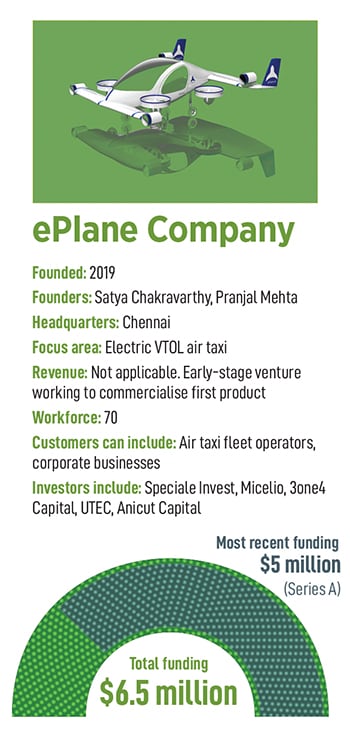ePlane Company: Making air taxis a reality
The IIT-Madras-incubated venture is developing one of the world's most compact electric VTOL passenger air taxis


Imagine skipping over all the traffic snarls of your metro to get to an important meeting on the other side of town, or a plant visit for an important customer—for a price not much more than what an Uber ride would cost for the same trip, but 10x faster.
That’s what Satya Chakravarthy wants to offer, with his vertical take off and landing (VTOL) all-electric air taxi, being developed at his venture, The ePlane Company. If he succeeds, it will be one of the first in the world.
Professor Satya, as everyone knows him at IIT-Madras, where he also built and heads the national centre for combustion research and development, started ePlane in 2019 with IIT Madras alumnus Pranjal Mehta, who left the company in 2022. In September, ePlane achieved an important milestone, securing a certification from India’s aviation regulator, the Directorate General of Civil Aviation.
This recognition, called the design organisation approval, now allows ePlane to go ahead and build its aircraft. “It means that when we build it, they will recognise it," Chakravarthy says.

“The first thing we had to work on was to crack the code on how to do a very compact winged aircraft that flies very slowly," Chakravarthy says.
That’s not trivial at all because conventionally slow flying aircraft are light-weight gliders, and the fast ones are more like jets. ePlane is trying to develop the opposite combination, that is to have very compact wings and fly very slowly. The wings help because one can use the airflow around them to create the lift needed for balancing the weight of the aircraft.
Chakravarthy envisions hundreds of these air taxis flying over our cities. This involves achieving the safety levels of airplanes and cost economics of cars. And he thinks ePlane will get there. The company is also in talks with potential strategic investors, including some large automakers, to raise more money.
“Where we are today is we have shown flight tests of a subscale prototype, which we are now going to commercialise for cargo applications," he says. “And we are on the way to making our first prototype of the full-scale two-seater of the taxi by the end of this year."
First Published: Oct 03, 2023, 12:28
Subscribe Now